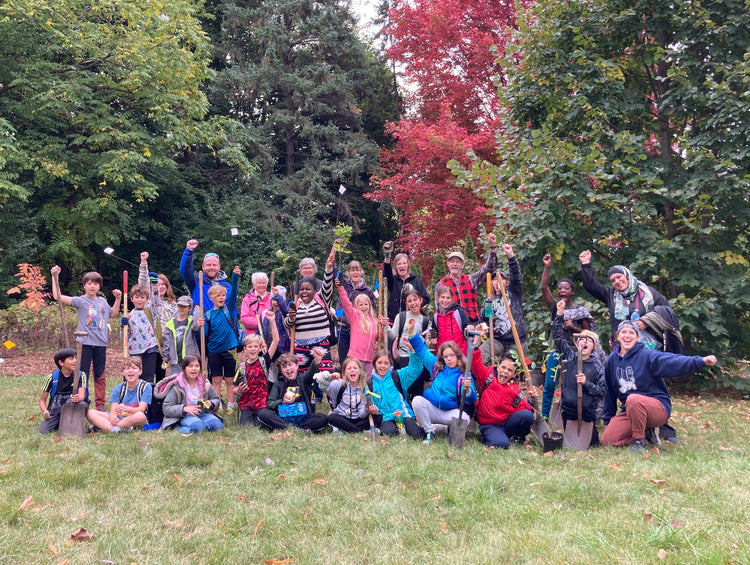Our community

Aerial photo of Grenville park in 1952, looking south. Mowat Hospital road (now Portsmouth Avenue, is at the left, and the east-west road is Bath Road
A couple of years after WW2 ended, a small group of teachers, academics and Alcan employees bought a 67-acre farm and brickworks a mile outside the Kingston city limits. The group had a vision to create a cooperative housing community from scratch that had a country feel and ample green space. 75 years later, Grenville Park is a leafy oasis in the heart of Kingston located between Bath Road and Portsmouth Avenue with 13 acres of parkland and 56 households.
Why we planted a Little Forest

In 2021, the community recognized that a 1-acre parcel of land at the corner of Westview and Grenville Roads was underutilized. Rather than continue to maintain the space as an expanse of turfgrass, the community decided to plant a small orchard and a Little Forest. The Little Forest will increase biodiversity, help manage stormwater flow, create a noise and visual barrier to Bath Road and reduce the amount of lawn that requires biweekly maintenance 6 months of the year. It will also be a convenient site where students and teachers can study ecology in its many forms.
Our design principles
 The community came together in June 2023 to discuss design priorities and concluded that the site should have:
The community came together in June 2023 to discuss design priorities and concluded that the site should have:
- a winding woodchip path through the centre of the forest. It is hoped that the path will be made of crushed stone at some future date since this substrate is considered moderately accessible for people with mobility challenges. In Ontario, design requirements and better practices for recreational trails suggest a 1.8m width to allow wheelchairs and scooters to pass; our path will be 3 m wide to allow for shrub growth at edges
- a glade at the west end that could function as a forest classroom for visiting students and teachers
- shrubs planted at edges of the forest and paths to create a softer, more aesthetically pleasing view
Species selection
One- and two-year-old plants were chosen based on several criteria:
- species representative of the layers naturally found within a mature forest (canopy, tall tree, understory and shrub)
- late seral, deciduous species
- shade tolerance given the existing mature trees at the site
- species that were dominant or common within the ecodistrict before European settlement
- significant ecological value for wildlife and
- species considered attractive by residents living close to the site

Students from a grade 5 class at Madeleine-de-Roybon Elementary School (MDR) also helped choose species as part of a class initiative that included applying for, and ultimately being awarded, a $500 grant. The grant allowed for the purchase of 43 native trees that the students researched, presented on, and helped plant in October 2023.
In total, students and community volunteers planted 390 seedlings and we look forward to Phase 2, when we will put an additional 1000 seedlings in the ground. The cost of purchasing 313 seedlings was $1544.49; the remaining 77 seedlings were grown from seed and donated. The following table shows the proposed species list, the forest layer that each species represents, and the primary criteria used in selecting the species for the site.

Preparing the forest floor

Approximately 20cm of arborist woodchips were applied to the site and allowed to decompose for 6-12 months prior to planting. In one section of the site where there was a lot of periwinkle and creeping Charlie, moistened cardboard was first placed on the ground and woodchips mounded on top to smother the weeds. Students from MDR and Mille-Îles High School enthusiastically helped residents with this work.
Our stewardship plan

For the next 3 years, the seedlings will be watered as required by residents of Grenville Park (and students from neighbouring schools whenever possible). Water has been generously provided by a neighbour living adjacent to the site. The thick woodchip layer will hopefully hold enough moisture so that a thorough watering will only be necessary a couple of times in the summer months for the first 3 years after planting.
Lessons learned
We are grateful that we started this project slowly with just 390 seedlings in the first year. There is much to learn in the process that we would have been overwhelmed had we planted 1000 trees in 2023. What will we do next year?
- involve more students of all ages; when they are taught proper planting techniques and supervised, students are remarkable planters, and their enthusiasm is infectious
- provide detailed training to a group of volunteers so that they feel qualified to supervise planting
- provide more supervised opportunities for residents to become involved in planting
- advertise the project to the wider Kingston community through social media and flyer drops and ask for planting help
- create a more festive, party-like atmosphere on planting days. This is a fun, community project, so it should feel like it!
Thanks
Our heartfelt thanks to Grenville Park residents who have been supportive of the project both financially and physically; those who have generously donated to our GoFundMe campaign; staff and students of Madeleine-de-Roybon Elementary School and Mille-Îles High School; Dale Sands at Woodfellas for the many loads of wood chips; Laurie and Sarah Quantick of environmental store Verde for the watering totes; Malette Electric for the use of their planting drills, and Kellar and Rob Scouten for allowing junior forest stewards to fill totes at their water tap.

